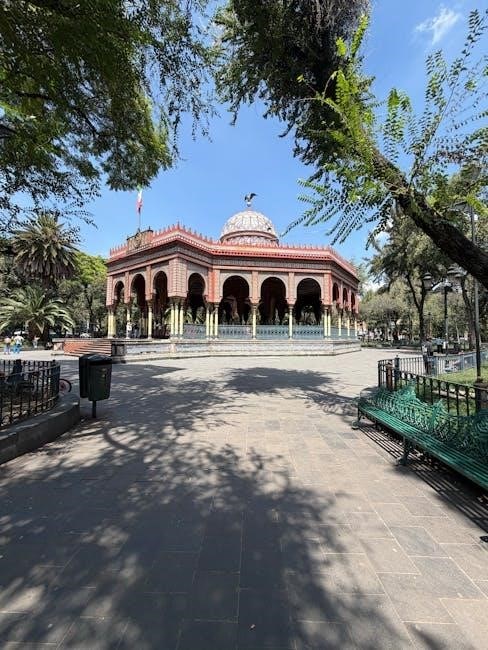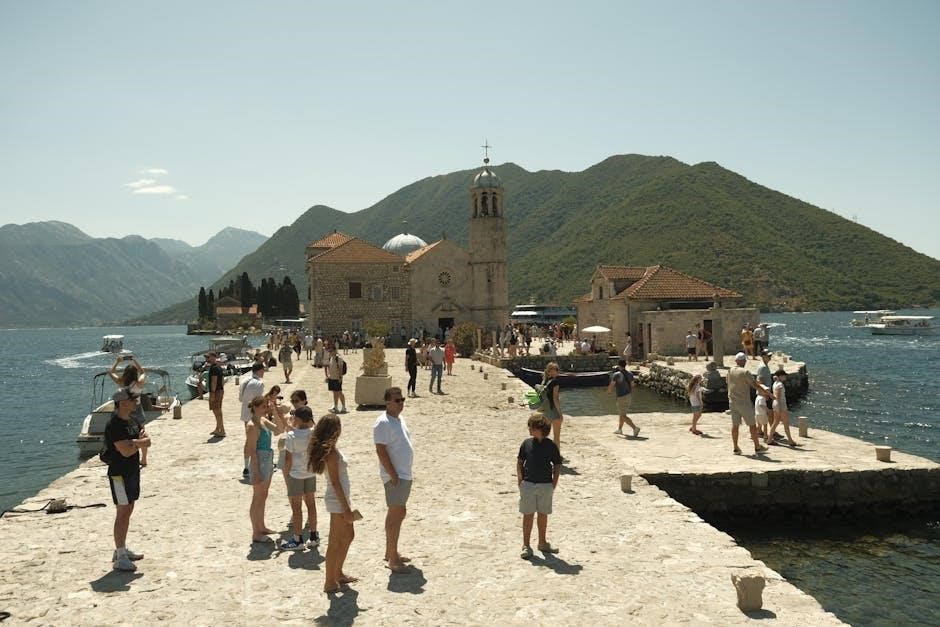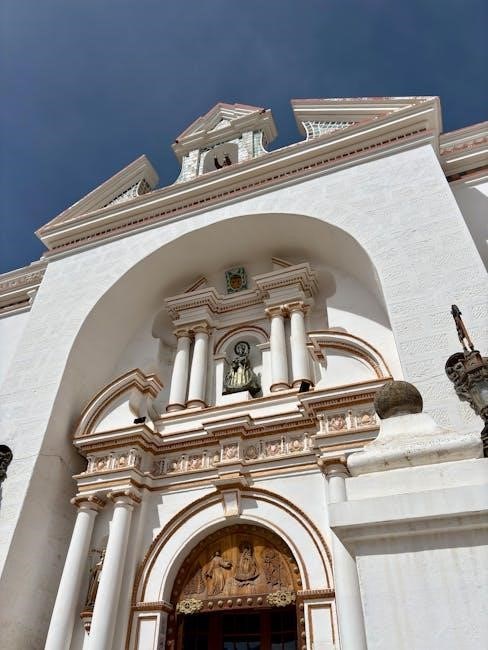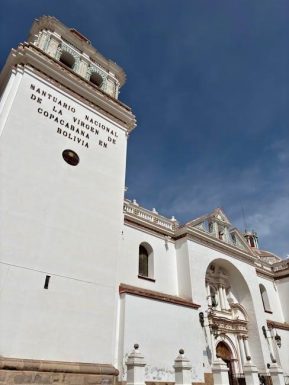Caste: The Origins of Our Discontents by Isabel Wilkerson is a Non-fiction book published in 2020, exploring caste systems globally, with a focus on America, India, and Nazi Germany, offering a unique perspective on social stratification and its historical roots.
1.1 Overview of the Book and Its Author
Isabel Wilkerson’s Caste: The Origins of Our Discontents is a profound exploration of caste systems and their impact on societies worldwide. Wilkerson, a Pulitzer Prize-winning author, examines how caste shapes social hierarchies, drawing parallels between India’s caste system, Nazi Germany’s racial policies, and America’s racial dynamics. The book blends history, narrative, and analysis to reveal how caste influences inequality, economic disparities, and human dignity. Wilkerson’s work is both a scholarly and deeply personal inquiry, offering a fresh lens to understand systemic oppression and its enduring legacy.
1.2 Relevance of the Topic in Modern Society
The concept of caste remains highly relevant in modern society, as it underscores the persistent inequalities and social hierarchies that shape human experiences globally. Wilkerson’s exploration of caste systems resonates deeply in today’s world, where issues like systemic racism, class divisions, and identity politics dominate public discourse. By examining caste, the book offers a framework to understand and address the root causes of inequality, making it a vital resource for fostering dialogue and change in contemporary society.
The Concept of Caste and Its Historical Roots
The concept of caste refers to a rigid social hierarchy based on birth, shaping access to resources and opportunities. Its historical roots trace back to ancient societies, where it became deeply entrenched, often justified through religious or cultural narratives, and continues to influence inequality and discrimination across the world.
2.1 Definition and Evolution of Caste Systems Worldwide
Caste systems are rigid social hierarchies where individuals are divided into groups based on birth, determining their status, rights, and opportunities. These systems are hereditary and enforceable through social norms or laws. Originating in ancient civilizations, such as India’s varna system, caste has evolved globally, adapting to cultural contexts while maintaining its core structure of inequality. It has been justified through religious, cultural, or racial narratives, perpetuating discrimination and division across societies. Understanding its evolution is key to addressing its enduring impact on modern disparities.
2.2 The Caste System in America: A Hidden Hierarchy
Isabel Wilkerson reveals that America operates under a hidden caste system, deeply rooted in race and history. Unlike India’s ancient varna system, America’s caste structure is informal yet pervasive, shaping opportunities and treatment based on racial identity. It is upheld by cultural norms, institutions, and historical practices like slavery and segregation. Wilkerson argues that this system is maintained through eight pillars, including hierarchy, heritability, and suppression of dissent. This invisible framework perpetuates inequality, influencing everything from education to healthcare, and remains a defining feature of American society.

Isabel Wilkerson’s Perspective on Caste
Isabel Wilkerson examines caste as a hidden structure shaping social dynamics, using historical and cultural analysis to reveal its pervasive influence across societies, including America.
3.1 Wilkerson’s Background and Inspiration
Isabel Wilkerson, a Pulitzer Prize-winning journalist, draws from her experiences growing up in a segregated America and her deep exploration of historical systems of oppression. Her inspiration for Caste: The Origins of Our Discontents stems from observing parallels between India’s caste system, Nazi Germany’s racial hierarchy, and America’s racial stratification. Wilkerson’s background in storytelling and social justice motivated her to uncover the invisible yet pervasive caste system shaping modern society, offering a framework to understand enduring inequalities and their roots in human history and culture.
3.2 The Eight Pillars of Caste Systems
Isabel Wilkerson identifies eight pillars that uphold caste systems worldwide: hereditary rankings, strict hierarchy, endorsement of inequality, religious justification, territorial segregation, occupational segregation, suppression of dissent, and the need for purity. These principles, evident in systems like India’s caste hierarchy and Nazi Germany’s racial policies, maintain dominance and control. Wilkerson argues these pillars are universal, adapting to local contexts while perpetuating inequality. They form the structural backbone of caste, ensuring its persistence across civilizations and generations, often invisible yet deeply entrenched in societal norms and institutions.
3.3 Linking Caste Systems Across Civilizations
Wilkerson explores how caste systems across civilizations share common mechanisms and principles. She draws parallels between India’s caste hierarchy, the U.S. racial caste system, and Nazi Germany’s racial policies. Each system relies on hereditary status, rigid hierarchy, and myths to justify inequality. Wilkerson argues these systems are interconnected, reflecting a universal human tendency to create and maintain dominance through caste. This cross-cultural analysis reveals shared patterns, such as the dehumanization of marginalized groups and the use of violence to enforce social order, highlighting the enduring nature of caste systems globally.

The Caste System in America
Wilkerson examines America’s caste system, rooted in race, with historical precedents like slavery and segregation. Modern disparities in healthcare, education, and criminal justice reflect caste-based inequalities.
4.1 Race as a Component of the Caste System
In Caste: The Origins of Our Discontents, Isabel Wilkerson argues that race in America functions as a component of a larger caste system, shaping social hierarchies and inequalities. Rooted in the legacy of slavery and segregation, race has historically been used to rank and oppress certain groups, perpetuating systemic discrimination. This framework influences access to resources, opportunities, and justice, creating enduring disparities. Wilkerson highlights how race-based caste distinctions are deeply embedded in American culture, impacting every aspect of society, from criminal justice to healthcare.
4.2 Historical Examples of Caste in America
Isabel Wilkerson examines historical examples of caste in America, such as the enslavement of Africans and the subsequent Jim Crow era. These systems established a rigid hierarchy, with enslaved people at the bottom and white Americans at the top. Laws and practices, like racial segregation and voter suppression, reinforced caste divisions. The legacy of these practices continues to influence modern inequalities, highlighting the enduring impact of historical caste systems on American society and its structures. Wilkerson connects these examples to broader caste frameworks globally.
4.3 Modern Manifestations of Caste
In modern America, caste manifests through systemic inequalities in criminal justice, housing, healthcare, and education. Wilkerson highlights how mass incarceration, voter suppression, and economic disparities disproportionately affect marginalized groups. These systems perpetuate racial and social hierarchies, often invisible to those in dominant groups. The book reveals how caste influences access to resources, opportunities, and social mobility, maintaining a hidden yet powerful structure of inequality. These modern expressions of caste are deeply rooted in historical frameworks, disguising themselves as meritocracy or individual failure.

Comparisons with Other Caste Systems
Wilkerson examines historical caste systems worldwide to reveal common mechanisms of oppression; This comparative approach highlights enduring patterns of social hierarchy and exclusion, offering insights into their persistence across time and cultures.
5.1 The Caste System in India
India’s caste system, one of the most rigid and ancient, is rooted in Hindu scripture, dividing society into hierarchical groups. The system categorizes people into varnas (classes) and jatis (subcastes), determining social, economic, and religious status. The lowest rung, “untouchables” or Dalits, faced extreme discrimination. Despite legal reforms, caste-based discrimination persists, influencing access to education, employment, and social mobility. Wilkerson draws parallels between India’s caste system and other global hierarchies, emphasizing universal themes of oppression and exclusion.
5.2 The Caste System in Nazi Germany
Nazi Germany’s caste system was a hierarchical framework rooted in racial ideology, with the Aryan race at the top. This system categorized people based on ethnicity, race, and perceived genetic purity. The Nuremberg Laws legally enforced these classifications, marginalizing Jews, Romani people, and others. Propaganda and state-sponsored violence were tools to maintain this hierarchy. Wilkerson highlights parallels between this systemic oppression and other caste systems, emphasizing how such frameworks dehumanize and justify inequality. This chapter underscores the dangers of ideologies that rank human value based on inherent traits.
5.3 Universal Principles of Caste Systems
Wilkerson identifies universal principles underlying caste systems, including rigid social hierarchies, division based on inherent traits, and mechanisms to enforce and perpetuate inequality. These systems rely on cultural narratives, legal frameworks, and violence to maintain dominance. Shared across civilizations, these principles create a structure where those at the top maintain power by dehumanizing and subjugating others. Such systems inhibit social mobility and justify discrimination, fostering long-term disunity and inequality within societies.

The Impact of Caste on Society
Caste systems perpetuate inequality, entrench social divisions, and limit opportunities, stifling societal progress by creating rigid hierarchies that marginalize certain groups, fostering distrust, and hindering collective advancement.

6.1 Social Stratification and Inequality
Caste systems create rigid hierarchies, dividing societies into layers with unequal access to resources, opportunities, and social mobility. This stratification perpetuates inequality, as lower castes face systemic barriers to education, healthcare, and economic advancement. Wilkerson highlights how caste fosters a culture of exclusion, marginalizing certain groups and reinforcing social and economic disparities. Such divisions undermine social cohesion, perpetuate poverty, and limit collective progress, as societal potential is stifled by the constraints imposed by caste-based hierarchies.
6.2 Economic and Educational Disparities
Caste systems perpetuate economic and educational disparities by restricting access to resources and opportunities. Lower castes often face limited job prospects, lower wages, and inadequate educational facilities, perpetuating cycles of poverty. Wilkerson underscores how these disparities are not accidental but systemic, rooted in caste hierarchies that devalue certain groups. Educational inequalities further entrench economic gaps, as marginalized communities struggle to access quality schooling, hindering social mobility and equality. These disparities reinforce caste-based privilege, creating a society where opportunities are unevenly distributed.
6.3 Psychological and Emotional Toll
The caste system inflicts profound psychological and emotional harm, fostering internalized beliefs of inferiority and superiority. Individuals in lower castes often experience shame, self-doubt, and anxiety, while those in higher castes may carry the burden of guilt or entitlement. Wilkerson highlights how caste systems create emotional labor, as marginalized groups constantly navigate systemic oppression. This mental strain leads to depression, trauma, and a diminished sense of self-worth, perpetuating cycles of inequality and limiting human potential across generations. The emotional toll is as damaging as the physical and economic disparities.

The Role of Power and Privilege
Power and privilege are central to caste systems, reinforcing hierarchy and dominance. Those in higher castes often wield systemic power, perpetuating inequality and maintaining their advantageous status.
7.1 Understanding Power Dynamics in Caste Systems
In Caste: The Origins of Our Discontents, Isabel Wilkerson explores how power operates within caste systems, often invisibly, to maintain hierarchy. Those in dominant castes wield institutional and social power, shaping norms, policies, and opportunities. This power is not only structural but also psychological, influencing how individuals perceive their place in society. Marginalized groups are systematically excluded from access to resources, perpetuating inequality. Wilkerson argues that understanding these dynamics is crucial to dismantling systems of oppression and achieving true social equity.
7.2 The Role of Privilege in Perpetuating Caste
In Caste: The Origins of Our Discontents, Isabel Wilkerson examines how privilege reinforces caste systems by granting unearned advantages to dominant groups. These privileges, often invisible to those who benefit, perpetuate inequality by ensuring access to resources, opportunities, and social acceptance. Conversely, marginalized groups face systemic barriers, limiting their ability to ascend. Wilkerson argues that recognizing and addressing these privileges is essential to dismantling caste systems, as they sustain the illusion of meritocracy and justify disparities in power and status.
7.3 Breaking the Cycle of Oppression
Breaking the cycle of oppression requires dismantling the structures that uphold caste systems. Education and awareness are critical, as they empower individuals to recognize and challenge ingrained biases. Encouraging empathy and understanding across caste lines fosters solidarity and collective action. Policy reforms and grassroots movements can address systemic inequalities, while individual accountability ensures that privilege is not wielded to perpetuate harm. Ultimately, breaking the cycle demands a societal commitment to equity, inclusivity, and the dismantling of hierarchical frameworks that sustain oppression.

The Intersection of Caste with Other Identities
Caste intersects with race, class, gender, sexuality, and religion, creating complex layers of oppression that amplify marginalization and shape individual and collective experiences uniquely;
8.1 Caste, Race, and Class
Caste, race, and class are deeply intertwined, creating a complex web of inequality. In America, race often serves as a proxy for caste, with historical discrimination shaping economic disparities. Class further entrenches these divisions, as access to resources and opportunities is limited by caste-based hierarchies. Wilkerson highlights how these systems intersect, perpetuating inequality across generations. Understanding this intersection is crucial for addressing systemic injustices and fostering equitable societies. The interplay of caste, race, and class remains a pivotal issue in modern America, influencing social mobility and identity.
8.2 Caste, Gender, and Sexuality
Caste, gender, and sexuality intersect to create unique experiences of oppression and identity. Women, particularly from lower castes, face double discrimination, while rigid gender roles reinforce caste hierarchies. Sexuality is often policed within caste systems, marginalizing those who defy norms, such as LGBTQ+ individuals. These intersections highlight how caste shapes personal and collective identities, perpetuating inequality and limiting social mobility. Wilkerson explores how these layers of identity compound disempowerment, emphasizing the need to address them holistically to dismantle caste-based oppression. The interplay of caste, gender, and sexuality remains a critical lens for understanding societal inequities in modern contexts.
8.3 Caste and Religion
Caste systems often intertwine with religious ideologies, reinforcing social hierarchies. Many religions, historically, have been interpreted to justify caste-based discrimination, with sacred texts used to legitimize inequality. In some cultures, religious doctrines are manipulated to sanctify the oppression of lower castes, framing it as divine order. Conversely, religion has also been a source of resistance, with leaders advocating for equality and challenging caste-based injustices. The interplay between caste and religion highlights how spiritual frameworks can both uphold and undermine systems of oppression, shaping societal attitudes and behaviors. This complex relationship remains deeply influential today.

The Role of Media and Education
Media and education shape perceptions of caste, influencing societal attitudes and understanding. They can either perpetuate stereotypes or challenge caste systems by promoting critical thinking and inclusivity.
9.1 Media Representation and Caste
Media representation plays a pivotal role in shaping perceptions of caste, often reinforcing or challenging societal hierarchies. In Caste: The Origins of Our Discontents, Isabel Wilkerson examines how media can perpetuate stereotypes or enlighten audiences. Historically, media has often overlooked caste-based injustices, contributing to their invisibility. However, it also holds the power to amplify marginalized voices and humanize experiences, fostering empathy and understanding. By addressing caste systems openly, media can challenge biases and promote equality, making it a critical tool for social change and awareness.
9.2 Education as a Tool for Change
Education serves as a powerful catalyst for dismantling caste systems by fostering awareness and critical thinking. In Caste: The Origins of Our Discontents, Isabel Wilkerson highlights how education can challenge entrenched hierarchies by exposing individuals to diverse perspectives. It equips people to question biases and redefine their identities. Educators play a crucial role in addressing caste-based disparities by integrating inclusive curricula and encouraging open dialogue. Through education, societies can cultivate empathy and understanding, paving the way for systemic change and equality.
9.3 The Role of Literature in Understanding Caste
Literature plays a vital role in illuminating the complexities of caste systems, offering insights into their historical and societal impacts. Isabel Wilkerson’s Caste: The Origins of Our Discontents masterfully employs storytelling and historical analysis to humanize the experiences of marginalized groups. Through narratives, literature dismantles stereotypes and fosters empathy, enabling readers to grasp the nuances of caste. By exploring diverse perspectives, literature becomes a mirror to society, urging reflection and inspiring collective action toward equality and justice.
Addressing Caste in the Modern World
Addressing caste requires a multifaceted approach, including activism, policy reform, and individual accountability to dismantle systemic inequality and promote equity in modern societies globally.
10.1 Grassroots Movements and Activism
Grassroots movements play a vital role in challenging caste systems by mobilizing communities to address inequality; Activism through protests, awareness campaigns, and advocacy has historically driven social change. Wilkerson highlights how collective efforts, often led by marginalized groups, can dismantle caste hierarchies. These movements emphasize education, empowerment, and solidarity, fostering a unified resistance against systemic oppression. By engaging individuals at the local level, grassroots initiatives create lasting impact, inspiring broader societal transformation and equity.
10.2 Policy Changes and Legal Reforms
Policy changes and legal reforms are essential in dismantling caste systems by addressing systemic inequalities. Wilkerson emphasizes the need for structural reforms to eliminate discriminatory practices embedded in laws and institutions. Historical examples, such as the repeal of Jim Crow laws in the U.S. and caste-based reservations in India, illustrate the impact of legal interventions. Modern reforms must target education, employment, and housing policies to ensure equal opportunities. Legal frameworks that promote equity can help erode caste hierarchies, fostering a more just society.
10.3 The Role of Individuals in Creating Change
Individuals play a pivotal role in challenging caste systems by advocating for equality and justice. Wilkerson highlights the importance of personal accountability and moral courage in dismantling oppressive structures. Through education, self-reflection, and allyship, individuals can disrupt harmful norms and practices. Grassroots activism, led by everyday people, has historically driven significant social change. By questioning biases and supporting marginalized communities, individuals can collectively create a more equitable society, proving that personal actions contribute to broader transformative movements.

The Book’s Reception and Impact
Wilkerson’s Caste received widespread critical acclaim for its profound insights into social hierarchies, sparking global conversations about race, inequality, and systemic oppression, while earning numerous awards.
11.1 Critical Reviews and Praise
Isabel Wilkerson’s Caste has garnered widespread acclaim for its meticulous research and compelling narrative. Critics praise its insightful exploration of systemic inequality, drawing parallels across histories and cultures. The book has been lauded for its ability to bridge academic rigor with accessible storytelling, making complex concepts relatable. It has received numerous awards, including the Pulitzer Prize and National Book Award nods, solidifying its impact as a seminal work. Readers and scholars alike have hailed it as a necessary exploration of social hierarchies, resonating deeply with its audience.
11.2 Controversies and Criticisms
While Caste: The Origins of Our Discontents has been widely praised, it has also faced criticism. Some scholars argue that Wilkerson’s framework oversimplifies the complexities of caste systems across different cultures and histories. Critics in Indian studies, for instance, have challenged her portrayal of the Indian caste system, asserting that it lacks historical nuance. Additionally, some have questioned the direct comparisons between race in America and caste in India, suggesting it may diminish the unique experiences of marginalized groups. These debates highlight the challenges of addressing caste’s intricate and varied manifestations.
11.3 The Book’s Influence on Public Discourse
Caste: The Origins of Our Discontents has significantly shaped public discourse on race, inequality, and social hierarchies. Wilkerson’s framework has sparked widespread conversations across media, academia, and policy circles. The book has been referenced in discussions about systemic racism, economic disparities, and social justice movements. Its impact is evident in curriculum adaptations in schools and universities, as well as in influential reviews and interviews. By reframing caste as a universal issue, Wilkerson has bridged historical and contemporary struggles, inspiring new perspectives on addressing inequality globally.
Caste: The Origins of Our Discontents offers a profound exploration of caste systems, linking history to modern disparities. Wilkerson’s work challenges readers to confront ingrained hierarchies, sparking hope for a more equitable future through awareness and collective action.
12.1 Summary of Key Points
Isabel Wilkerson’s Caste: The Origins of Our Discontents explores the insidious nature of caste systems worldwide, tracing their historical roots and modern manifestations. She argues that caste, often hidden yet deeply ingrained, shapes social hierarchies, perpetuating inequality and discontent. Wilkerson examines caste in India, Nazi Germany, and America, revealing startling parallels. Her eight pillars of caste systems provide a framework for understanding these structures. The book underscores the need for awareness and collective action to dismantle caste-based oppression, offering hope for a more equitable society. Wilkerson’s work is a call to confront and transform these enduring systems.
12.2 The Future of Caste Systems and Society
The future of caste systems and society hinges on acknowledging and dismantling these entrenched hierarchies. Wilkerson emphasizes education, awareness, and collective action as vital tools for change. By understanding the historical roots of caste, societies can work toward equity and inclusion. While challenges remain, the book offers hope, suggesting that recognizing caste’s pervasive influence is the first step toward its dissolution. A future free from caste-based oppression requires intentional efforts to challenge and transform these systems, fostering a more just and unified world.
12.3 Final Thoughts on the Book’s Message
Isabel Wilkerson’s Caste delivers a profound and timely message, urging readers to confront the invisible hierarchies that shape societies. By tracing caste’s pervasive influence across civilizations, she illuminates its role in perpetuating inequality. The book calls for unity and recognition of shared humanity, emphasizing that dismantling caste requires collective effort. Wilkerson’s work challenges readers to reflect on their own roles within these systems, offering a hopeful vision of a future where dignity and equity are accessible to all, regardless of caste, race, or identity.
